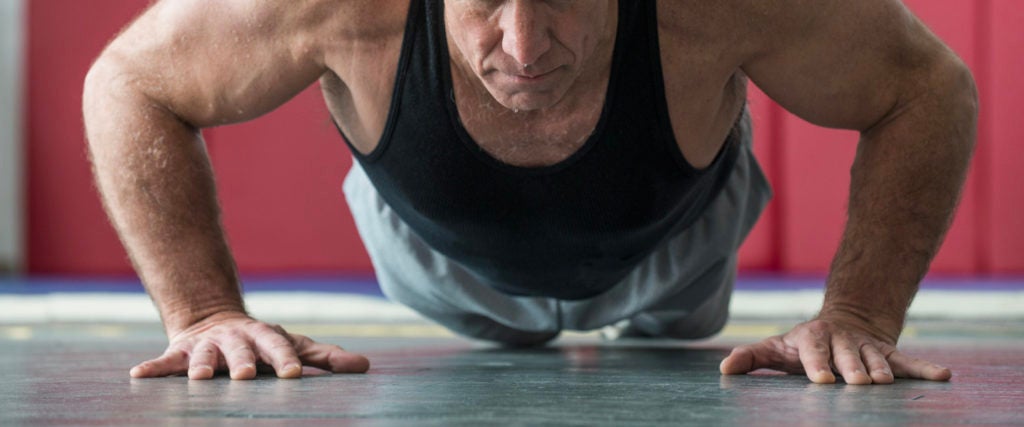I remember the day when a Bally Total Fitness member tried explaining to me how pull-ups would give someone a “big chest.” He was wrong, of course: Pull-ups alone won’t give someone a big chest because they can’t. The chest isn’t a prime mover in the pull-up exercise, which primarily targets the back muscles. At the same time, this gym member’s assertion was only falsifiable because he’d included the word “big.” If he’d simply said that pull-ups “work the chest,” I couldn’t have objected so strenuously, because pull-ups do work the pectoralis minor. That’s not enough to give someone a big chest, but it does work the chest in a general sense.
This is why it can be so challenging to answer questions about the muscle groups that are worked by specific exercises. Yet, while it can be challenging to explain why a bench press isn’t necessarily considered a shoulder exercise even though it does work your anterior deltoids, that’s nothing compared to the challenge of having to explain whether or not an exercise like the push-up works the abs.
Why is it so hard to explain if push-ups work the abs?
The flaw inherent in the question of whether or not something “works the abs” is that we need to define what we mean by “work.” Depending on how you answer that question, there are myriad exercises you would ordinarily overlook that definitely work the abs in a general sense, and there are a ton of exercises that certainly work the abs, but are unlikely to give you the results you’re looking for.
For example, there are certain cardiovascular movements that may not specifically target the abs, but place your abdominal muscles under some form of tension. This training method won’t be nearly as focused as when you ensure that you’re squeezing at the peak of a muscle contraction and forcing all of the blood you can into your abdominal walls. But you also need to ask the question as to whether or not you’d even be pleased with the sort of midsection you’d ultimately develop if you placed your abs under the same type of weight-induced stress that you would to train your chest or your biceps.
You just used a whole lot of words that I don’t quite understand. What do you mean by all of that?
Here’s what I’m getting at: If you place a muscle under heavy stress, you tend to develop large, powerful muscles. If you place a muscle under light stress and train it in high volume, this tends to elicit muscles that are smaller, but durable. Many bodybuilders who train for aesthetics eschew heavy abdominal lifts in favor of high-rep movements like crunches, which will enable you to maintain a trim midsection, and also help you to emphasize and accentuate the development of large chest, back and shoulder muscles.
Granted, it’s not like your abdominal muscles are going to go from Bruce Banner to the Incredible Hulk overnight; you’re bound to notice the gradual growth before things have gone completely off the rails. Even so, keep in mind the sort of midsection you’d like to have and then train your abs in a way that’s conducive to achieving your desired physique.
Early on you mentioned that there are some abdominal training exercises that I might not be thinking of.
Not abdominal exercises per se — we’re talking about exercises where the abdominals are indirectly involved, but the result is that they end up being strenuously worked. For example, movements like deadlifts, squats and lunges — which are regarded primarily as exercises that train the back and legs — place the entire muscular system under the stress of the weight, and require you to brace your midsection with all your might in order to maintain the optimal posture. Powerlifters like Kevin Oak rarely train their abdominals directly, if ever, yet they’re still able to shatter world squatting records. So you can’t tell me they don’t have strong abdominals.
Honestly, though, if you’re doing pull-ups or chin-ups with your legs angled out in front of you, your abs are being trained. If you’re doing standing dumbbell curls with proper, rigid form, your abdominals are stabilizing your body as you move the weights with your arms. When you do standing military presses, your midsection is forced to work to prevent you from swaying. All things considered, if you’re performing all of your non-abdominal-focused lifts correctly, there’s a chance you may never have to set aside time to train your abdominals directly.
But you never answered the question: Do push-ups work the abs or not?
I was getting there! Geez…
Yes, push-ups train abs in a very indirect way. If you’re familiar with a planking movement, the same principle applies to the push-up: You’re bracing with your core to maintain an optimal body position, and although you’re relying primarily on your chest and triceps to move your body through space, your abdominals are forced to fire constantly in order to hold your body in place. In fact, one of the reasons why some people may not be able to do as many push-ups is because their abdominals lack the endurance to lock them into place long enough for them to fully maximize the work of their chest and triceps.
Personally, I wouldn’t rely on push-ups to deliver the entirety of my abdominal stimulation, but a push-up is certainly better than nothing. Not to mention, it will help you build prominent chest and tricep muscles; it will administer muscle-building benefits throughout your upper body; and stringing together 50 of them in a row will allow you to brag to your friends about how you could qualify to be a Navy SEAL if you really felt like it.
All of which, if you ask me, far exceed the tertiary benefits to your abs.

